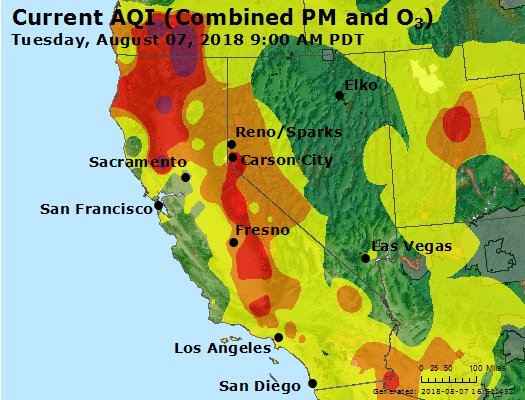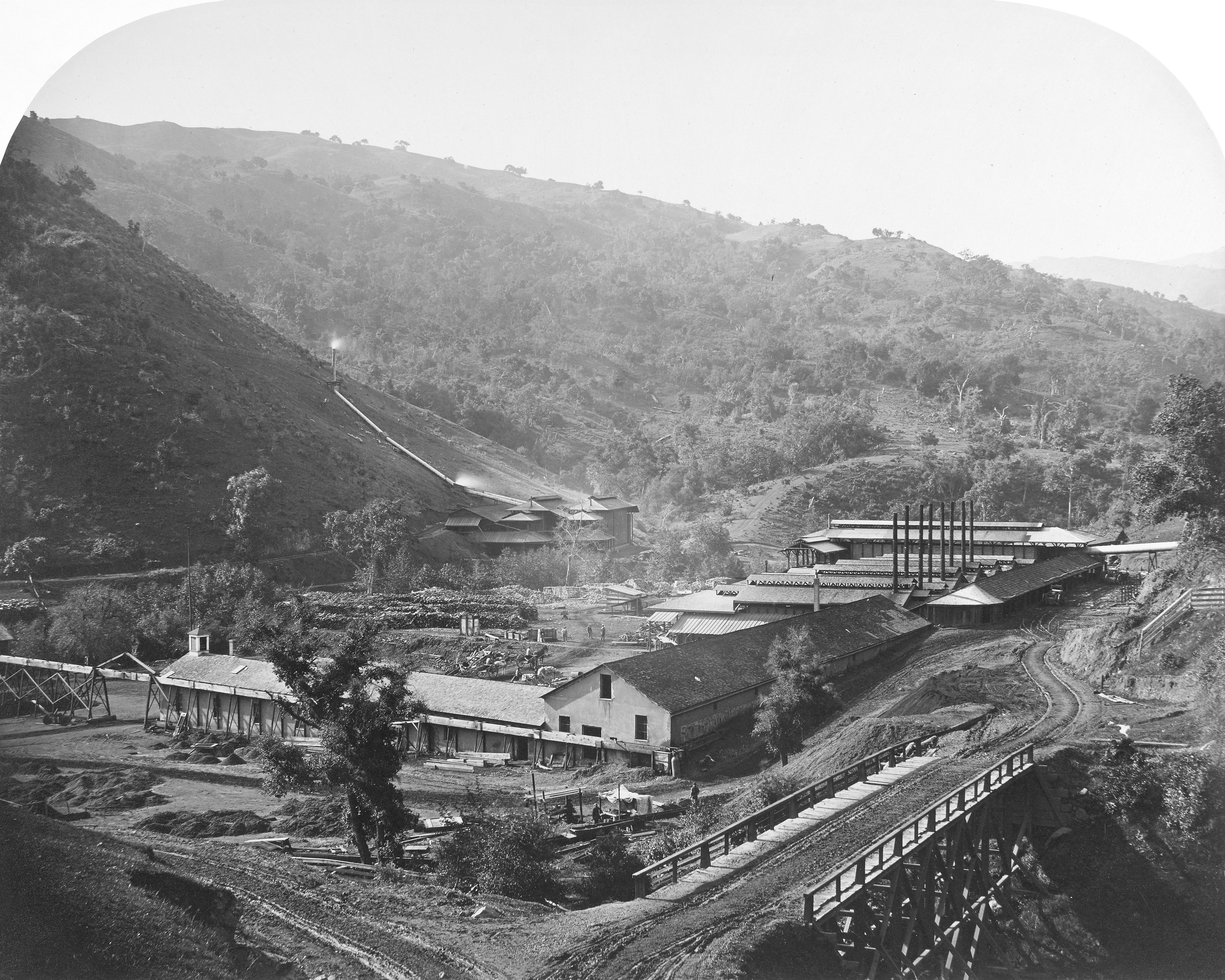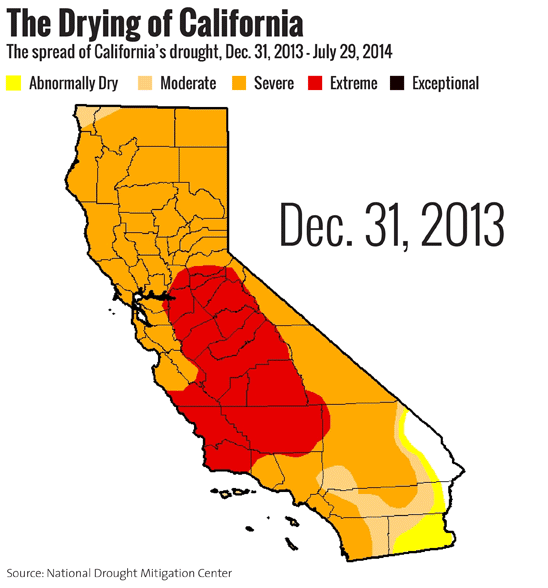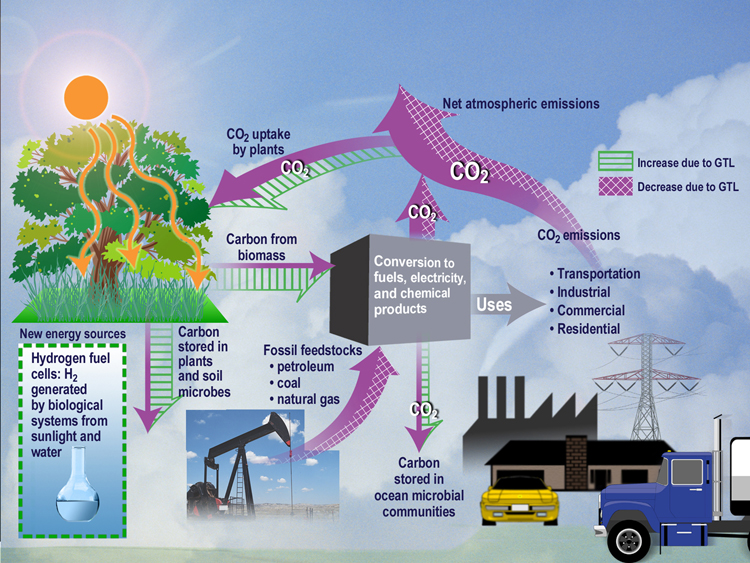|
2018 California Wildfires
The 2018 wildfire season was the deadliest and most destructive wildfire season in California history. It was also the largest on record at the time, now third after the 2020 and 2021 California wildfire seasons. In 2018, there were a total of 103 confirmed fatalities, 24,226 structures damaged or destroyed, and 8,527 fires burning , about 2% of the state's 100 million acres of land. Through the end of August 2018, Cal Fire alone spent $432 million on operations. The catastrophic Camp Fire alone killed at least 85 people, destroyed 18,804 buildings and caused $16.5 billion in property damage, while overall the fires resulted in at least $26.347 billion in property damage and firefighting costs, including $25.4 billion in property damage and $947 million in fire suppression costs. In mid-July to August 2018, a series of large wildfires erupted across California, mostly in the northern part of the state. On August 4, 2018, a national disaster was declared in Northern California, ... [...More Info...] [...Related Items...] OR: [Wikipedia] [Google] [Baidu] |
Natchez Fire
The Natchez Fire was a wildfire that burned near the California and Oregon Border in Siskiyou County, California, in the United States. The Natchez Fire began on July 15, 2018, due to lightning, and the fire burned a total of before it was fully contained on October 30, 2018. Timeline The Natchez Fire ignited 8 miles north of Happy Camp on July 15, 2018, around 6:30 P.M. PDT, due to lightning. During the next couple of weeks, the Natchez Fire gradually expanded in size, reaching by July 31, with 15% containment. The fire continued to burn into the month of August, while continuing to grow. On August 11, 2018, the fire had burned a total of and was 52% contained. By August 14, 2018, the fire had burned a total of and was 55% contained. The fire continued to grow in size during the next couple of weeks. On August 31, the Natchez Fire had burned and was 70% contained. During the first week of September, the Natchez Fire quickly expanded in size, due to a heat wave and dry condi ... [...More Info...] [...Related Items...] OR: [Wikipedia] [Google] [Baidu] |
Global Warming
In common usage, climate change describes global warming—the ongoing increase in global average temperature—and its effects on Earth's climate system. Climate change in a broader sense also includes previous long-term changes to Earth's climate. The current rise in global average temperature is more rapid than previous changes, and is primarily caused by humans burning fossil fuels. Fossil fuel use, deforestation, and some agricultural and industrial practices increase greenhouse gases, notably carbon dioxide and methane. Greenhouse gases absorb some of the heat that the Earth radiates after it warms from sunlight. Larger amounts of these gases trap more heat in Earth's lower atmosphere, causing global warming. Due to climate change, deserts are expanding, while heat waves and wildfires are becoming more common. Increased warming in the Arctic has contributed to melting permafrost, glacial retreat and sea ice loss. Higher temperatures are also causing m ... [...More Info...] [...Related Items...] OR: [Wikipedia] [Google] [Baidu] |
Central Valley (California)
The Central Valley is a broad, elongated, flat valley that dominates the interior of California. It is wide and runs approximately from north-northwest to south-southeast, inland from and parallel to the Pacific coast of the state. It covers approximately , about 11% of California's land area. The valley is bounded by the Coast Ranges The Pacific Coast Ranges (officially gazetted as the Pacific Mountain System in the United States) are the series of mountain ranges that stretch along the West Coast of North America from Alaska south to Northern and Central Mexico. Although th ... to the west and the Sierra Nevada to the east. The Central Valley is a list of regions of California, region known for its agricultural productivity: it provides more than half of the fruits, vegetables, and nuts grown in the United States. More than of the valley are irrigated via reservoirs and canals. The valley hosts many cities, including the state capital Sacramento, California, Sacramento ... [...More Info...] [...Related Items...] OR: [Wikipedia] [Google] [Baidu] |
Wildland–urban Interface
The wildland–urban interface (WUI) is a zone of transition between wilderness (unoccupied land) and land developed by human activity – an area where a built environment meets or intermingles with a natural environment. Human settlements in the WUI are at a greater risk of catastrophic wildfire. Definitions In the United States of America, the wildland-urban interface (WUI) has two definitions. The US Forest Service defines the wildland-urban interface qualitatively as a place where "humans and their development meet or intermix with wildland fuel." Communities that are within of the zone are included. A quantitative definition is provided by the Federal Register, which defines WUI areas as those containing at least one housing unit per . The Federal Register definition splits the WUI into two categories based on vegetation density: * Intermix WUI, or lands that contain at least one housing unit per in which vegetation occupies more than 50% of terrestrial area; a heavi ... [...More Info...] [...Related Items...] OR: [Wikipedia] [Google] [Baidu] |
San Jose Mercury News
''The Mercury News'' (formerly ''San Jose Mercury News'', often locally known as ''The Merc'') is a morning daily newspaper published in San Jose, California, in the San Francisco Bay Area. It is published by the Bay Area News Group, a subsidiary of Digital First Media. , it was the List of newspapers in the United States#Top 25 newspapers by circulation, late 2012 through early 2013, fifth largest daily newspaper in the United States, with a daily circulation of 611,194. , the paper has a circulation of 324,500 daily and 415,200 on Sundays. As of 2021, this further declined. The Bay Area News Group no longer reports its circulation, but rather "readership". For 2021, they reported a "readership" of 312,700 adults daily. First published in 1851, the ''Mercury News'' is the last remaining English-language daily newspaper covering the Santa Clara Valley. It became the ''Mercury News'' in 1983 after a series of mergers. During much of the 20th century, it was owned by Knight Ridder. ... [...More Info...] [...Related Items...] OR: [Wikipedia] [Google] [Baidu] |
Climate Change
In common usage, climate change describes global warming—the ongoing increase in global average temperature—and its effects on Earth's climate system. Climate change in a broader sense also includes previous long-term changes to Earth's climate. The current rise in global average temperature is more rapid than previous changes, and is primarily caused by humans burning fossil fuels. Fossil fuel use, deforestation, and some agricultural and industrial practices increase greenhouse gases, notably carbon dioxide and methane. Greenhouse gases absorb some of the heat that the Earth radiates after it warms from sunlight. Larger amounts of these gases trap more heat in Earth's lower atmosphere, causing global warming. Due to climate change, deserts are expanding, while heat waves and wildfires are becoming more common. Increased warming in the Arctic has contributed to melting permafrost, glacial retreat and sea ice loss. Higher temperatures are also causing m ... [...More Info...] [...Related Items...] OR: [Wikipedia] [Google] [Baidu] |
Climate Change In California
Climate change in California has resulted in higher than average temperatures, leading to increased occurrences of drought and wildfires. During the next few decades in California, climate change is likely to further reduce water availability, increase wildfire risk, decrease agricultural productivity, and threaten coastal ecosystems. The state will also be impacted economically due to the rising cost of providing water to its residents along with revenue and job loss in the agricultural sector. California has taken a number of steps to mitigate impacts of climate change in the state. Paleoclimatological evidence Paleoclimatological studies indicate that the last 150 years of California's history have been unusually wet compared to the previous 2000 years. Tree stumps found at the bottom of lakes and rivers in California indicate that many water features dried up during historical dry periods, allowing trees to grow there while the water was absent. These dry periods were asso ... [...More Info...] [...Related Items...] OR: [Wikipedia] [Google] [Baidu] |
California Wildfires
This is a partial and incomplete list of California wildfires. California has dry, windy, and often hot weather conditions from spring through late autumn that can produce moderate to severe wildfires. Pre-1800, when the area was much more forested and the ecology much more resilient, 4.4 million acres (1.8 million hectares) of forest and shrubland burned annually. California land area totals 99,813,760 or roughly 100 million acres, so since 2000, the area that burned annually has ranged between 90,000 acres, or 0.09%, and 1,590,000 acres, or 1.59% of the total land of California. During the 2020 wildfire season alone, over 8,100 fires contributed to the burning of nearly 4.5 million acres of land. Wildfires in California are growing more dangerous because of the accumulation of wood fuel in forests, higher population and greater electricity transmission and distribution lines. United States taxpayers pay about US$3 billion a year to fight wildfires, and big fires can lead to b ... [...More Info...] [...Related Items...] OR: [Wikipedia] [Google] [Baidu] |
Noah Diffenbaugh
Noah S. Diffenbaugh (born ) is an American climate scientist at Stanford University, where he is the Kara J Foundation Professor of Earth System Science and Kimmelman Family Senior Fellow at the Stanford Woods Institute for the Environment, and an affiliate at the Precourt Institute for Energy. From 2015-2018, he served as editor-in-chief of the peer-review journal ''Geophysical Research Letters'' (published by American Geophysical Union). He is known for his research on the climate system, including the effects of global warming on extreme weather and climate events such as the 2011-2017 California drought. Scientific research Diffenbaugh received his Ph.D. in Earth Sciences from the University of California, Santa Cruz in 2003. His dissertation was entitled “Global and regional controls on Holocene environments”. His dissertation focused on understanding regional climate change in paleoclimate periods and in modern periods. His dissertation introduced the hypothesis tha ... [...More Info...] [...Related Items...] OR: [Wikipedia] [Google] [Baidu] |
Earth System Science
Earth system science (ESS) is the application of systems science to the Earth. In particular, it considers interactions and 'feedbacks', through material and energy fluxes, between the Earth's sub-systems' cycles, processes and "spheres"—atmosphere, hydrosphere, cryosphere, geosphere, pedosphere, lithosphere, biosphere, and even the magnetosphere—as well as the impact of human societies on these components. At its broadest scale, Earth system science brings together researchers across both the natural and social sciences, from fields including ecology, economics, geography, geology, glaciology, meteorology, oceanography, climatology, paleontology, sociology, and space science. Like the broader subject of systems science, Earth system science assumes a holistic view of the dynamic interaction between the Earth's spheres and their many constituent subsystems fluxes and processes, the resulting spatial organization and time evolution of these systems, and their variability, sta ... [...More Info...] [...Related Items...] OR: [Wikipedia] [Google] [Baidu] |
Stanford University
Stanford University, officially Leland Stanford Junior University, is a private research university in Stanford, California. The campus occupies , among the largest in the United States, and enrolls over 17,000 students. Stanford is considered among the most prestigious universities in the world. Stanford was founded in 1885 by Leland and Jane Stanford in memory of their only child, Leland Stanford Jr., who had died of typhoid fever at age 15 the previous year. Leland Stanford was a U.S. senator and former governor of California who made his fortune as a railroad tycoon. The school admitted its first students on October 1, 1891, as a coeducational and non-denominational institution. Stanford University struggled financially after the death of Leland Stanford in 1893 and again after much of the campus was damaged by the 1906 San Francisco earthquake. Following World War II, provost of Stanford Frederick Terman inspired and supported faculty and graduates' entrepreneu ... [...More Info...] [...Related Items...] OR: [Wikipedia] [Google] [Baidu] |







